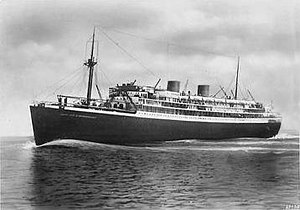This article needs additional citations for verification. (December 2010) |
 An early photo of Johan van Oldenbarnevelt
| |
| History | |
|---|---|
| Name | Johan van Oldenbarnevelt |
| Owner | Netherland Line |
| Operator |
|
| Port of registry |
|
| Route |
|
| Builder | NSM, Amsterdam |
| Yard number | 194 |
| Launched | 3 August 1929 |
| Completed | 13 March 1930 |
| Decommissioned | 3 February 1963 |
| Refit |
|
| Identification |
|
| Fate | Sold to the Shipping Investment Corporation and renamed TSMS Lakonia |
| Name | Lakonia |
| Owner | Shipping Investment Corporation |
| Operator | Greek Line |
| Port of registry | Greece |
| Acquired | 8 March 1963 |
| Fate | Damaged by fire at sea 22–24 December 1963 and sank while under tow 29 December 1963 |
| General characteristics | |
| Type | Ocean liner |
| Tonnage | 19,040 GRT |
| Length | 586.2 ft (178.7 m) |
| Beam | 74.8 ft (22.8 m) |
| Depth | 36.1 ft (11.0 m) |
| Decks | 4 |
| Installed power | 1,555 NHP |
| Propulsion |
|
| Speed | 19 kn (35 km/h; 22 mph) |
| Capacity |
|
| Notes |
|
TSMS Lakonia was an ocean liner that was launched in 1929 for Netherland Line as the ocean liner Johan van Oldenbarnevelt. In 1962 she became the Greek Line cruise ship TSMS Lakonia. On 22 December 1963 she caught fire at sea and on 29 December she sank. 128 people were killed in the disaster.
In the 1930s Johan van Oldenbarnevelt's regular route was between Amsterdam and the Dutch East Indies. She served in the Second World War as an Allied troop ship. She was refitted several times and latterly became a cruise ship.
In 1962 Netherland Line sold her to a Greek company, the Shipping Investment Corporation, who renamed her Lakonia and for whom the Greek Line managed her for cruising. From April 1963 Greek Line operated her on cruises from Southampton.
On 22 December 1963 fire broke out on the ship when she was about 200 miles (320 km) north of Madeira during a Christmas cruise. As the fire spread, alarms sounded too softly to be heard by most people aboard. Evacuation was hampered by the overcrowding of lifeboats and the loss of several boats to fire. Some deaths were caused by the fire itself, others by accidents when abandoning ship, and others by exposure or drowning in the sea.
Lakonia's crew successfully launched just over half of her lifeboats. Some passengers were able to reach the water via gangways and rope ladders. Two ships alerted by distress signals managed to save most of the others.
On 24 December ocean tugs took Lakonia in tow and tried to tow her to Gibraltar. But the ship had developed a list and on 29 December she sank in the Atlantic.
A board of inquiry determined the fire to be due to faulty electrical wiring and strongly criticised the maintenance of equipment, thoroughness of lifeboat drills, and the standard of supervision. Eight of the ship's officers were charged with negligence.